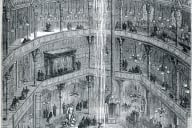You have /5 articles left.
Sign up for a free account or log in.
Last week The New York Times published a reproduction of a poison-pen letter that Martin Luther King Jr. received 50 years ago this month, a few weeks before he accepted the Nobel Peace Prize. A couple of passages in the screed suggest it was accompanied by audiotape of MLK in a hotel room, indulging in a round of extramarital recreation. King and his circle assumed that J. Edgar Hoover was behind the whole thing – a reasonable guess, since bugging a hotel room counted as a sophisticated surveillance operation in 1964.
Portions of the letter have been quoted by King’s biographers for years, and Hoover’s animus against King and the rest of the civil rights movement was obvious enough. But in her essay for the Times, Beverly Gage -- the history professor from Yale who found the original draft in the National Archives – underscores something that only shows through with the whole document in front of you. It might be called an element of psychosexual frenzy.
The note -- prepared by one of Hoover’s agents, but reflecting his own preoccupations regarding King -- purported to be from a disillusioned African-American supporter. MLK’s “alleged lovers get the worst of it,” writes Gage. “They are described as ‘filthy dirty evil companions’ and ‘evil playmates,’ all engaged in ‘dirt, filth, evil and moronic talk.’ The effect is at once grotesque and hypnotic, an obsessive’s account of carnal rage and personal betrayal…. Near the end, it circles back to its initial target, denouncing him as an ‘evil, abnormal beast.’ ”
All in a day’s work at J. Edgar’s FBI. The only thing surprising about the note is the lack of any charge that King was a Communist Party stooge. Hoover’s practice of collecting information on the sex lives of prominent individuals served the perfectly straightforward function of bolstering his personal authority, of course. And it worked: he served as the bureau’s director for almost 50 years, in part because he had the goods in his hands to derail any effort to replace him. But there is also a hint of voyeurism to the director’s “Official/Confidential File.” Blackmail is power -- and power, as someone once said, is the ultimate aphrodisiac.
The director only comes onstage about halfway through Jessica R. Pliley’s Policing Sexuality: The Mann Act and the Making of the FBI (Harvard University Press). It would be excessive to call Hoover a minor figure in the book, but it certainly displaces him from his familiar status as prime mover in the bureau’s history.
Pliley, an assistant professor of women’s history at Texas State University, begins a generation or two before the creation of the Bureau of Investigation in 1908 (the name was changed in 1935), with the stresses and strains of American society in the late 19th century that ultimately gave rise to one of the laws the bureau tried to enforce: the Mann Act, which made it a felony to transport “any woman or girl” across state lines “for the purpose of prostitution or debauchery, or for any other immoral purpose.”
The law, passed in 1910, now seems almost idiomatically peculiar: As with the decision to make alcohol, tobacco, and firearms the purview of a single law-enforcement agency, most people would have a hard time explaining the logic behind it. Pliley traces its roots to a series of moral panics in the United States over the changes induced by the country’s rapid expansion and urbanization. A growing national economy brought with it an expanded market for prostitution -- the horrors of which were summed up by 19th-century reformers as “white slavery.”
"[M]easures to reassert control over the American libido were always one or two steps behind the social changes -- and enforcement could never be much more than episodic."
That phrase expressed the moral fervor of the abolitionist spirit finding a new cause, while also carrying its share of racial overtones, especially in sensational accounts of blue-eyed girls servicing the lusts of nonwhite customers. The influx of immigrants was another concern. Women finding their way in a new country were especially vulnerable. But there was also the need to protect America's precious bodily fluids from the contaminating influence of foreign cultures, with their deplorably lax moral standards and unwholesomely exotic bedroom practices. (Despite the xenophobia, there was something to the last point. By the 1920s, any bordello trying to keep its clientele had to offer “the French,” i.e., fellatio.)
Urbanization and the automobile multiplied the temptations for other sins of the flesh, as well as the venues for committing them. The danger of a young woman being seduced and abandoned after false promises of marriage became more intense when parents knew that the cad might impregnate her in the rumble seat, then drive off to who knows where.
Pliley devotes most of the first third of her book to building up, layer by layer, a picture of the trends and anxieties of the period -- some of them overblown, but with enough examples from the legal record of women raped and then forced into sexual labor to show that it wasn’t all a matter of yellow journalism.
Pliley also discusses various laws and social campaigns that emerged in response -- efforts to shore up the norms by which sexual activity would be restricted to monogamous, legally married straight couples of the same race, who, while not necessarily born in the U.S., otherwise tried to make themselves as inconspicuous as possible. But measures to reassert control over the American libido were always one or two steps behind the social changes -- and enforcement could never be much more than episodic.
When Representative James R. Mann proposed the White Slave Traffic Act (soon to be known by his name) to Congress in 1910, its odd mandate reflected the effort to patch over some of the existing gaps in terms just broad enough to cover problems that ever-faster means of transportation were bound to create.
It met a little opposition. One Congressman expressed concern that “immoral purposes” was so vague that it might apply to horse racing and chicken fighting. Southern politicians were initially troubled that the law might infringe on states’ rights, but found themselves charged with a lack of concern with the protection of white womanhood, which settled the matter soon enough. President Taft signed the bill into law the day Congress sent it to his desk.
The burden of enforcing the Mann Act soon fell to the Justice Department’s recently formed Bureau of Investigation, which had a small staff and not much precedent for how to proceed. An early investigation seemed like a promising way to crack the organized traffic in prostitution between bordellos in Connecticut, Louisiana, and other states. But it turned out the hookers operated as free agents who traveled from bordello to bordello in a circuit. Customers, madams, and sex workers alike seem to have found it a reasonably satisfactory arrangement.
Pliely points out that the whole “white slavery” discourse rested on the idea that women wanted, more or less by instinct, to establish a monogamous relationship and start a family, and would only enter or remain in prostitution under threat of violence. But the interstate pimp ring that turned out not to exist suggested otherwise. The author shows that a great deal of the case load for agents in the early decades of the bureau pertained to cases of adultery where the lovers had fled the state. The aggrieved spouse could charge the adulterous man with violating the Mann Act, despite his paramour being perfectly happy with the situation. She had been taken “across state lines for immoral purposes,” though the investigation usually ended once she had agreed to return to her husband.
Thanks to the Great Depression, the bureau was able to enter the headlines for cases involving banks robbers and gangsters – and, a bit later, political radicals, as well as professional spies. But Pliley notes that in the late 1930s, Hoover (who joined the bureau in 1919 and became director five years later) reasserted the original understanding of the Mann Act as a measure against prostitution.
“The Bureau investigated only when the right person invited it,” she writes, “a father, a husband, or a male local law enforcement official. When the Bureau considered aggravated cases of sexual exploitation, it almost always conceived of prosecuting these crimes as defending the family (and concomitantly upholding men’s rights to control the sexuality of their dependents) rather than upholding an idea of female sexual sovereignty.”
It seems almost superfluous to mention the other implicit requirement: the man in question had to be white. The author names a few cases in which the complainant was of another color, but it seems that the most agents ever did was to fill out some paperwork, presumably to humor him.
None of this can really be attributed to Hoover, though. He executed the law, and enforced its biases, but they were established well before he joined the Bureau.
Policing Sexuality takes the story up to roughly America’s entry in World War Two, but I think the surveillance of MLK and the vicious letter from 50 years ago take on a new aspect in light of Pliley’s research. She directs our attention away from the director to the matrix in which the Bureau took shape. That challenges the habit of regarding the FBI as an institution shaped, and distorted, by his personality -- parts of which are expressed in the letter to King, written by a subordinate who knew what he wanted.
But the letter also echoes the concerns that Pliley finds in the Mann Act well before Hoover took power. Besides hostility to African-American advancement (one undercurrent of the "white slavery" theme), it expresses a fervent, one might even say deranged, aversion to sex outside of marriage. That Hoover shared these attitudes made him a perfect fit for the job. He thrived in it, and was good at it, although “good” isn't really how it looks from here.




